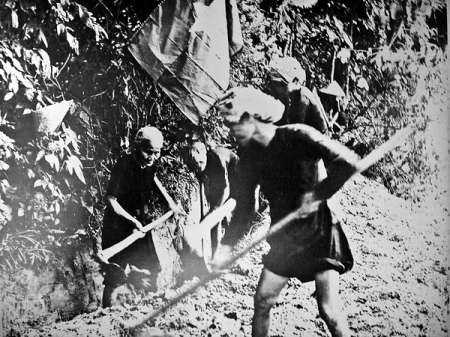Holding a role in two resistance wars, the tunnel was ranked as national historical and cultural remain of 230,000 square meters on March 18th, 1996.

The name 'iron triangle' was familiar to many in resistance war against the US Army event though they might not have been to the place. Today, many hold many understanding of 'iron triangle'. Many believe that the place is located in Southwest of Ben Cat but many say it includes the Southwest of Ben Cat, Dau Tieng, and Long Nguyen, even wider areas from Long Nguyen of Ben Cat through Trang Bang (in Tay Ninh) and Cu Chi (in Ho Chi Minh City). They are all right regarding the locations in the 'iron triangle' through the steps of war developments. However, few may think that 'iron triangle' was originated from 3 communes of An Dien, An Tay, and Phu An.
In resistance war against the French colony, the area of the 3 communes in Southwest Ben Cat was infamous of An Thanh warbase which was then the stop station of resistance war commanding headquarter of the South, special committee of Saigon, etc. to call upon locals to join revolutionary movements at the soonest in the most challenging stages of the resistance war against the US Army with sacrifices of our people.
By 1948, the first underground tunnel was created in the land and then in 1960, Cu Chi guerillas followed the model to construct locally.
The enemy raids again and again failed to undermine local people determination. The underground tunnel helped to evade overwhelming oversea raids of the US Army in the South, namely in 1967 with the greatest and most modern human-killing equipment in Operation Cedar Falls on January 2-21, 1967 including large-scale military forces of 30,000 soldiers, 400 tanks, 80 warships, 100 cannons, and various bombing aircrafts including B52 stratafortress; however, the complex tunnel system failed the raid, resulting in retreat of the US Army losing 3,200 soldiers, 149 tanks, 28 aircrafts, and 2 warships. Sniper Nguyen Van Duc was notorious for killing 9 by only 10 bullets or the daring venture of Vo Thi Huynh in the battle field to take care of and protect injured soldiers.
In the face of continual failures, the region was named 'iron triangle'.
.jpg)
The place had become a symbol of revolutionary actions and resistance wars. Using primitive tools, local people succeeded in creating a marvelous tunnel system which is unique as tons of soils had been digged up and put secretly somewhere else, showing the tight cooperation of local people and the armed forces. The auxiliary families of the zone were connected to the tunnel system to create the connection of production and fighting.
The main route of the tunnel system is 4 meters underground to bear 1.2 meters high and 0.8 meter wide tunnel. In some parts of the system, the tunnel is 'constructed' with 2 up to 3 levels with secret access from above the ground. The tunnel is designed with necessary turns and ventilation holes carefully camouflaged. Around the entries are set with secret pitches, mines, and anti-tank, and anti-helicopter pitches in order to prevent enemy approach.
Large basements for resting, storing foods, and hospitalizing injured soldiers are inter-connected to the tunnel.
The tunnel branches connect the hamlets. Accompanied with the tunnel branches is the fighting hubs. For each 1km of a tunnel branch, 3 fighting hubs are allocated in areas of well-camouflaged pitches and mine fields.
The tunnel system is nearly 100 kilometers long with about 50 fighting hubs and hiding chambers for treatment of injured soldiers and storigng of weapons and foods. The tunnel system was considered as warbase and battlefield. Major combats had been organized from such base including the Le Hong Phong Campaign in 1950, ambush, and anti-raids.
The construction and re-enforcement of the tunnel system had been comprehensive in terms of politics, military, and economics. Local organizations of Party, authority, and fronts had taken good care of local people, creating unity.
The tunnel system had been significant for resistance wars, especially, the stage of warding off US Army to unify the nation. In 20 years of war, the tunnel system proved to be of combat value to bury thousands of enemies and their equipment. In Spring 1968, the place helped to ward off enemies heading to Saigon, contributing to the victory of 1975.